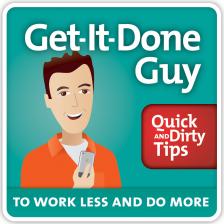What Should You Put on a Business Card?
Get-It-Done Guy explains how to make your business card work for you.
Listener Scot asked:
“I have three business cards. One for work, one for my non-profit avocation, and one for my personal information, for people I actually like. What information goes on each? What’s the etiquette for handing them out (will they just get thrown away)?”
Scot, 3 business cards? You’re as over-the-top as I am. There’s a lot to say about business cards (who knew?) so let’s jump right in.
Business cards make it easy for people to remember you and then contact you. That’s it. Assume someone will take it home, type it in, and throw it away. That’s if they remember you. Don’t worry about making your card memorable; make yourself memorable and jot down a personalized memory hook on your card before you give it to someone.
Check out Get-It-Done Guy episode 30, Successful Networking, for details.
Include Your Basic Contact Information Only
Your card only needs your company name, your name and title, phone number, email address, and website. Street addresses are more optional now that paper mail has given way to email. I leave it off. If someone wants to send something, they can call to arrange delivery. If they’re sending a bill, I pretend the call got dropped and let their follow-up go to voicemail. Technology! I just love technology!
Show some backbone. Commit to one set of contact information and give it out. Don’t send people on a scavenger hunt to find you.
If you have a direct phone line, don’t include a main office number. No one with your direct line wants to call the main office; it’s you they like. And if you have multiple offices, don’t put them all on one card. No one on the planet knows how to enter that in their address book, or even how to use the information if they could enter it. Should they call both offices? Just one? The main number? Your number? Which should they call first? Where should they leave a message?
Show some backbone. Commit! (I realize your ex used to say that. Maybe you should have listened.) Commit to one set of contact information and give it out. Don’t send people on a scavenger hunt to find you. Unless you’re really, really important, few people will make the effort. And if you are that important, the kinds of people you give your business card to are not people whose time you want to waste.
Non-Profit Business Cards
Your nonprofit card is the same: company, name, phone, and email. I would include a tagline making it clear what the nonprofit does. Nonprofits appeal to values, which are strong connecting forces. So with absolutely no evidence whatsoever, I believe highlighting your cause on your card gives an extra emotional oomph to people who share your values. “Solar energy for a sustainable future,” “Educating the most needy,” “Curing hunger, one gastric stomach band at a time.”
If your for-profit has a cute Web 2.0 name like Zunk, Bloop, Plop, BoxBe, Burble, or Splook (all of which are active websites as I write this), include a tagline so people have a clue what you do. And tell your branding people that if you don’t have the money for a mass market campaign to explain your company name to 100 million people, choosing a descriptive name can be useful. Zipcar. I’ll bet it’s about cars. It’s a zippy, fast car rental company. Who’d have thought it? Everyone, because it says something.
Personal Business Cards
When I got my first business cards, I fell so in love with their shiny goodness that I immediately ordered “personal cards.” They’re for people I want to be friends with. I still go minimal: name, phone number, and private email address. I only give my street address to people who promise to bring oreo ice cream cake and, of course, the paparazzi.
My friend Ashton’s personal card is even more minimal. It just says “Ashton,” has an anonymous cell phone number, and an anonymous webmail address. If you’re thinking “Why would they do that?” forget it, you don’t need to know. If you’re thinking “What a great idea! That would make things so much easier!” more power to you. Just be safe.
Business Card Design

Never laminate cards or use funky translucent wax paper. Use paper that takes gel ink or ballpoint ink so people can write notes on your card.
Test your design in a scanner. Busy, high-powered people scan business cards. Make sure yours comes in correctly. Put a v by your voice line, m by your mobile number, and f by your fax to help the scanning software. Don’t label your email address “email,” or your website address “website.”
Anyone who can’t figure out that getitdone@quickanddirtytips.comcreate new email is an email address is not someone I want to hear from unless they’re prepared to give me large sums of money. And it’s obvious that quickanddirtytips get it done guy is a website address where you can find links to the effective networking episode and a ton of other amazing info.
Good luck with your cards. Remember: just the essentials, no matter which card it is. Make sure it’s easy for someone to contact you; your card is all about their convenience, not your ego. Include name, phone number, email and a single address. Leave lots of whitespace and use card stock that takes all kinds of ink. And above all, make sure you’re so memorable that you don’t need to leave a card to be remembered.

This is Stever Robbins. Connect with me on Facebook at Facebook GetItDoneGuy
Work Less, Do More, and have a Great Life!
Images Courtesy of Shutterstock.







